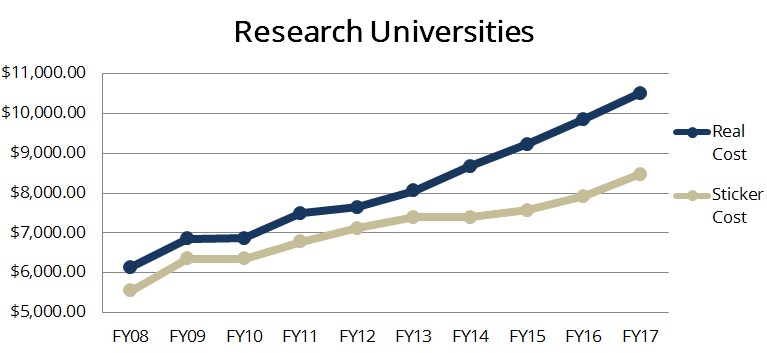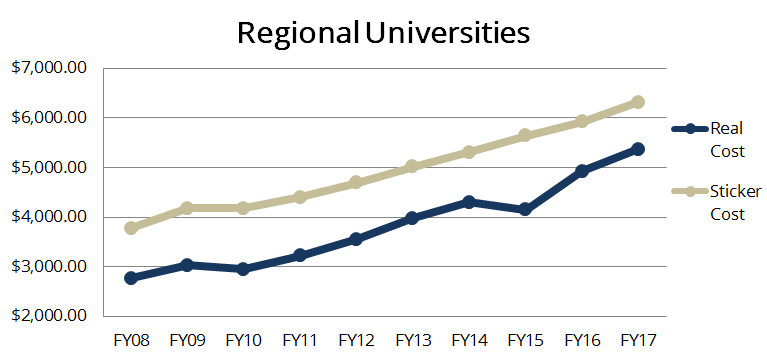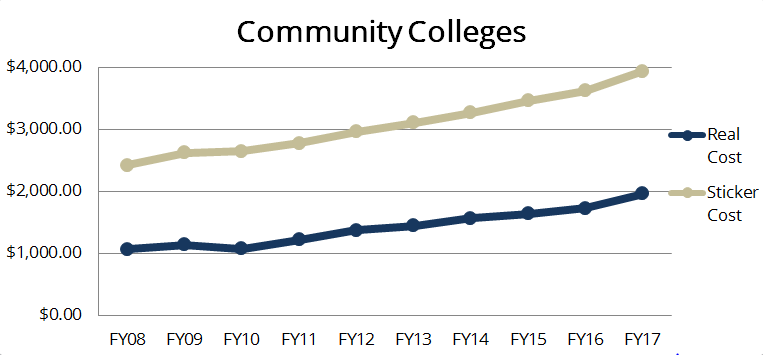Higher Education
Tuition sticker price is not the real cost to students, families
Cody Ray Milner | August 14, 2017
Key Points
- The hourly sticker price for tuition is just a part of the actual annual price.
The Oklahoma Regents for Higher Education met June 28 and 29 to review state appropriation levels for the 2018 Fiscal Year and decide on the ever-pressing question of just how much state universities and colleges may charge their students in tuition--this year increasing rates an average of 5.3%. Unfortunately, this hourly cost is only loosely connected to how much incoming students will actually pay for their education.
But these hourly prices fail to tell the whole story.
One challenge is that the hourly sticker price for tuition is just a part of the actual annual price. Last year’s sticker price for tuition was approximately $160 per credit hour at the major research universities (University of Oklahoma and Oklahoma State University), $150 per hour at regional universities, and $100 per hour at community colleges.
But these hourly prices fail to tell the whole story. Factor in mandatory fees per credit hour and students are looking at $280 per hour at research universities, $210 at regional universities, and $130 at community colleges, pushing annual tuition and fee totals up to $8,500, $6,300, and $4,000 (respectively).
The larger problem is that even adding up all these costs fails to predict how much the average student will actually pay. In 2017, higher education generated $1.6 billion in revenue from tuition and fees (an increase of $640 million over the last five years). Factor that by the roughly 225,000 enrollees in 2016-2017 and the average student across the state paid over $7,100 in tuition and fees last year.[1]
Broken down by type of institution students at research universities paid an average of $10,500 last year, versus $5,400 at regional universities and $2,000 at community colleges. These are all real dollars paid into the system, not scholarship reductions awarded by universities or the state. And unlike the sticker price that averages a 6% increase each year, the real cost per student has increased 12% a year over the past decade.
The real cost per student isn’t all bad news for families looking to pay for an affordable education. Students attending community colleges average a real cost that’s less than half of the tuition sticker price. On the other hand, attending Oklahoma State University or the University of Oklahoma could cost students up to $2,000 more than the price that’s advertised. (Of course, each individual student’s costs and financial aid amounts will vary, but these numbers represent the averages for students in these institutions according to state data.)
Although the Oklahoma Board of Regents voted to approve a 5.3% tuition hike, this number fails to tell the whole story. As Oklahoma’s students and families begin another college semester, they’ll need to remember to look past the flashy sticker price to locate the true cost that they’ll actually be paying.
[1] The 2016-2017 total enrollment numbers have not yet been released by the State Regents, but fall 2016 enrollment numbers indicated a 0.3% decrease from 2015-2016’s enrollment of 226,575 students.
Chapter 2



- [1] The 2016-2017 total enrollment numbers have not yet been released by the State Regents, but fall 2016 enrollment numbers indicated a 0.3% decrease from 2015-2016’s enrollment of 226,575 students.
Cody Ray Milner
Policy Associate
Cody is an undergraduate student at Oklahoma Christian University, majoring in Political Science and American History and minoring in International Studies and Economics. Cody has previously worked for Oklahoma Governor Mary Fallin, U.S. Senator James Lankford, and Americans For Prosperity.